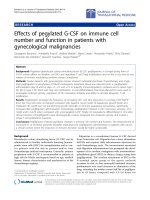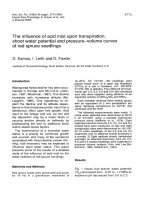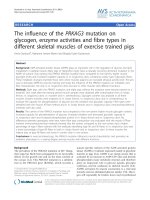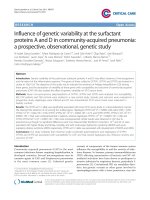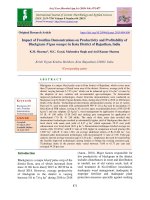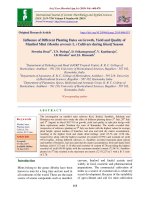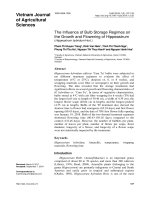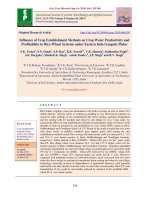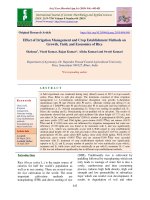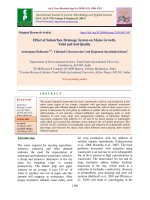Influence of crop establishment methods on crop water productivity and profitability in rice-wheat systems under eastern Indo Gangetic plains
Bạn đang xem bản rút gọn của tài liệu. Xem và tải ngay bản đầy đủ của tài liệu tại đây (350.39 KB, 10 trang )
Int.J.Curr.Microbiol.App.Sci (2019) 8(6): 259-268
International Journal of Current Microbiology and Applied Sciences
ISSN: 2319-7706 Volume 8 Number 06 (2019)
Journal homepage:
Original Research Article
/>
Influence of Crop Establishment Methods on Crop Water Productivity and
Profitability in Rice-Wheat Systems under Eastern Indo Gangetic Plains
S.K. Tomar1, S.N. Singh2, A.P. Rao3, R.K. Naresh4*, V.K. Sharma5, Sudhanshu Singh5,
S.K. Bargaha6, Shailesh K. Singh7, Ashok Pandey8, J.P. Singh9 and R.V. Singh2
1
K V K Belipar, Gorakhpur; 2K V K, Basti; 3Directorate of Extension; 6K V K Ayodhya;
7
K V K Amethi; 8K V K Siddharthnagar; 9K V K Azamgarh
Narendra Dev University of Agriculture & Technology Kumarganj, Ayodhya (U.P.), India
4
Department of Agronomy, SardarVallabhbhai Patel University of Agriculture & Technology,
Meerut, (UP), India
5
Division of Soil Science, Indian Agricultural Research Institute New Delhi, India
*Corresponding author:
ABSTRACT
Keywords
Crop establishment
methods, Drum
seeder, Zero tillage,
Profitability, RiceWheat system
Article Info
Accepted:
04 May 2019
Available Online:
10 June 2019
Rice-Wheat cropping system pre-dominated in the India covering an area of about 10.5
million hectare. Adverse effect of continuous puddling in rice field forced scientists to
search for other methods of rice establishment like direct seeding; machines transplanted
and dry seeding with ZT machine and wheat by zero tillage etc. In a 3‐year study, we
assessed the effects of crop establishment methods in participatory mode on farmers’ field
through on farm on productivity and profitability in a rice–wheat (RW) system at Basti,
Siddharthnagar and Gorakhpur district of U.P. Result of the study revealed that rice sown
with drum seeder in puddled condition gave highest grain yield among the rice
establishment methods tested. Rice sowing with drum seeder yield was increased 4.1, 11.4
and 25.6 % over farmer practice in Basti, Siddharthnagar and Gorakhpur locations,
respectively. Wheat planted in Rice (UPMTP) - Wheat (ZT) gave 4.6 tha-1 grain yields
than FP. Zero tillage wheat sown obtained 10.4, 13.5 and 12.5 % higher yield over the
farmers practice in Basti, Siddharthnagar and Gorakhpur locations. Treatment unpuddled
mechanical transplanted rice and zero tillage wheat recorded highest rice equivalent yield
9.9 t ha-1yr-1. Treatments rice (DSR) – wheat (ZT) followed by rice (DMS) –wheat (ZT)
and rice (UPMTP) –wheat (ZT) obtained higher net return and B: C ratio. However,
compared with traditional practice of cultivation farmers much convinced with rice sown
either dry direct seeded or mechanical transplanted drum seeding and wheat by zero tillage
technology, especially in terms of independency of agricultural labourers, yield potential
and benefit-cost ratio. Results from this study revealed that conventionally tilled (CT) and
transplanting of rice could be successfully replaced by adoption of the profitable DSR wheat ZT in –rice-wheat system.
259
Int.J.Curr.Microbiol.App.Sci (2019) 8(6): 259-268
inherent soil characteristics and climatic
conditions. Puddling effects adversely on soilphysical condition for establishment and
raising the succeeding crops (Bhatt et al.,
2015). This practice is water, capital and
energy intensive, and deteriorates soil health
(Das et al., 2014).
Introduction
Rice and wheat are staple food crops of the
world cultivated on an area around 370.4 m
ha. A large proportion of world population
relies on rice and wheat for daily caloric
intake, income and employment. Rice-wheat
cropping system is one of the major cropping
systems in South Asia and is practiced in 14
million hectares area (Singh et al., 2010)
providing food for more than 400 million
people. The rice–wheat production systems
are fundamental to employment, income, and
livelihoods for hundreds of millions of rural
and urban population of South Asia
(Saharawat et al., 2010). This system covers
about 10.5 million hectares in India
contributes 26% of total cereal production,
60% of total calorie intake and about 40% of
the country’s total food basket (Sharma et al.,
2015). In India rice occupies nearly 44.1
million hectares area, 105.5 million tonnes
total production with a productivity of 2291
kgha-1 productivity for the year 2014-15
(Anonymous, 2016). Rice is the most
important staple food in Asia, where more
than 90% of the world‟s rice is grown and
consumed.
Puddling leads to the formation of a hard-pan
at shallow depths deteriorates soil physical
properties and delays planting of a succeeding
wheat crop. Timely planting of wheat is
crucial as yield reductions of 1–1.5% per day
occur for each day after the optimum sowing
date, November 15 in the IGP (Jat et al.,
2009). Therefore, it is imperative that
alternate method of growing crops that are
more water efficient and less labour intensive
to be developed to enable farmers to produce
more with less cost of production. Huge
labours
are
needed
to
accomplish
transplanting of rice seedlings and mostly it is
delayed to a greater extent due to
unavailability of adequate labours during
transplanting peak. Thus, late planted rice
takes more time to reach the maturity, which
not only reduces the rice yield but also delays
sowing of succeeding crop particularly wheat
but direct seeding of rice can reduce the
labour and water requirement, shorten the
duration of crop by 7-10 days and provide
comparable yield with transplanted rice
(Mishra et al., 2012). In plains of Eastern
India, sowing of wheat gets delayed due to
wet condition after rice harvesting which
takes much time to come in working
condition, also tillage in such soils require
more time, labour and energy. On the other
hand, zero tillage minimizes loss on account
of delayed sowing as it advances the wheat
sowing by 10-15 days and also saves the time
and cost involved in field preparation.
Conventional methods of wheat sowing,
which requires excessive tillage delays the
sowing and reduce the yield, but the same can
be accomplished efficiently with use of
Tillage is one of the basic inputs of crop
production, actually tillage alters the
rhizosphere environment by modifying most
of the physical properties of the soil, viz. bulk
density and soil strength, hydraulic
conductivity and aggregates stability,
infiltration rate and porosity due to formation,
destruction and rearrangement of soil particles
and aggregates and alternation in clod size
distribution (Kurothe et al., 2014). In the
conventional systems involving intensive
tillage, there is gradual decline in soil organic
matter by quicker oxidation and burning of
crop residues causing pollution, greenhouse
gases emission, and loss of valuable plant
nutrients. However, the extent of the impacts
of tillage is variable depending upon the
260
Int.J.Curr.Microbiol.App.Sci (2019) 8(6): 259-268
improved machines, viz. zero till ferti-seed
drill and rotavator etc. to save the time, fuel,
energy and cost (Bohra and Kumar, 2015).
Therefore, the present investigation was
envisaged with an objective to identify a
suitable combination of crop establishment
method for maximum productivity and
profitability from rice –wheat cropping
system.
tillage on environmental concert (Derpsch et
al., 2014). The experiment was laid out in
farmers’ participatory mode and farmer is
treated as replication. The experimental
design was randomized block design keeping
five crop establishment methods viz.,T1=
manual transplanted rice- wheat conventional
practices (CTPR) –(CSW) FP;T2= puddled
direct wet seeded rice by drum seeder—wheat
zero tillage (PDSR)-(ZTW); T3= unpuddled
direct seeded rice by zero till cum ferti seed
drill – wheat zero tillage (DSR)-(ZTW);
T4=unpuddled rice transplanted by machine –
wheat zero tillage (UMTPR)- (ZTW) and T5=
unpuddled rice transplanted by machine–
wheat roto till (UMTPR) – (RTW). A uniform
dose of 150 kg N, 60 kg P2O5, 40 kg K2O and
5 kg Zn ha-1 was applied for rice and wheat
crops in all the treatments through urea (46 %
N), DAP (18% N and 46% P2O5), muriate of
potash (60 % K2O) and ZnSO4 respectively.
Half of total nitrogen and full dose of P2O5,
K2O and Zn were applied to rice crop as basal
(sowing/transplanting) and remaining half
dose of nitrogen in the form of urea was top
dressed in two equal splits, at active tillering
and panicle initiation stage, respectively. Rice
variety NDR 3112 and wheat variety HD
2967 was used for sowing / transplanting with
recommended seed rate.
Materials and Methods
Experimental site
A farmers’ participatory field experiment was
established
in
the
year
2015
at
Siddharthnagar, Gorakhpur and Basti districts
of Uttar Pradesh under Narendra Dev
University of Agriculture & Technology,
Ayodhya, with rice (Oryza sativa L.)–Wheat
(Triticum aestivum L.) cropping system. The
region has a semi-arid to sub-humid climate
with an average annual temperature of 19.3
0
C.The highest mean monthly temperature
(40.7 0C) is recorded in May, and the lowest
mean monthly temperature (4.50C) is
recorded in January. The average annual
rainfall is about 1050 to 1080 mm of which
around 87% is acknowledged for the duration
of monsoon period. Remaining 13% rainfall is
received during the non-monsoon period in
the wake of western disturbances and thunder
storms. The experimental soils sandy loam/
loam in texture having pH (7.80-8.60), EC
(0.16-0.38dSm-1), organic carbon (0.27 -0.29
%), available N (102-252 kg/ha), available
P2O5 (10.0-26.5 kgha-1) available K (110-265
kgha-1), available S (10.3-23.5 kgha-1), DTPAextractable Zn (0.46-.62 mgkg-1), Fe (2.906.25 mgkg-1), Mn (3.44-8.60 mgkg-1) and Cu
(0.65-1.58 mgkg-1) and available B (0.20-0.32
mgkg-1).
Rice was transplanted on June 20th to 27th and
wheat was sown on November 15th to 20th
during experimentation. The herbicide
glyphosate (1 kg ha-1 ) was applied in zero-till
treatments before the seeding to knock down
the weeds, pendimethalin 1kg ha-1 (preemergent) fb bispyribac 25g ha-1 at 20
DAS/DAT were applied by using knap sack
sprayer with flat fan nozzle for weed control
in rice and for wheat, Sulfosulfuran 33g +
20g/ha metsulfuron was applied at 30 DAS.
The crop was harvested at maturity stage.
First, the border rows were harvested and
separated. Later, crop from net plot was
harvested and sun dried. The harvested
material from each net plot was carefully
Experimental design and management
A comprehensive description of unlike tillage
systems is essential to compare effect of
261
Int.J.Curr.Microbiol.App.Sci (2019) 8(6): 259-268
bundled, tagged and brought to the threshing
floor separately. Threshing was done plot
wise and grains were cleaned, dried and
weighed separately for each net plot and
computed in terms of kg ha-1 at 14% moisture
level. The straw yield was also recorded plot
wise after sun drying and computed to kg ha1
.Test weight (g) of 1000-seeds from each plot
was recorded. The economics are calculated
viz. Gross and return (₹ ha-1) and B: C ratio
separately. The data recorded for different
crop parameters were analysed using analysis
of variance (ANOVA) technique (Gomez and
Gomez, 1984) for complete randomized block
design. Where ANOVA was significant, the
treatment means were compared using LSD
procedure at 5% level of significance.
establishment method of rice sown with drum
seeder recorded highest grain yield followed
by mechanical transplanting in puddled
condition, mechanical transplanting in unpuddled condition and dry direct seeding by
ZT machine using stale bed technique. Higher
grain yield in drum seeder sown crop might
be due to optimum plant population and depth
of sowing with appropriate other yield
attributes. Poor performance in conventional
method of transplanting (FP) was due to less
plant population /m2. Similar or high yield
attributes and yield of rice were reported
earlier by many researchers [Ladha et al.,
(2009) and Jat et al., (2009) Yadav et al.,
(2014)].
Effect of crop establishment method on
wheat
Results and Discussion
Different sowing method of wheat had
significant variation in yield attributes viz.
effective tillers /m2, number of grains /spike,
1000 grain weight and grain yield (Table 2).
Wheat sown by zero tillage after conventional
puddled transplanted rice recorded highest
grain yield 44.5, 46.3 and 47.5 q/ha at Basti,
Gorakhpur and siddharthnagar location
followed by zero till wheat sown after dry
direct seeded rice. Irrespective of various crop
establishment methods, zero till sown wheat
by gave 5.93% higher yield over conventional
sowing wheat. Higher grain yield under zero
till sown wheat were due to more number of
effective tillers, grain /panicle and test weight.
The possible reason for higher yield attributes
and grain yield in zero till sown wheat might
be due to the effect in better equilibrium
between macro and micro-porosity leading to
increased root biomass in the surface soil
layer. Conventional tillage had obtained the
lowest wheat yield because wheat crop
suffered the ills of puddling in preceding rice
crop resulting in poor rooting due to soil
compaction and poor aggregation as reported
by other researchers in the region (Jat et al.,
Effect of crop establishment methods on
rice crop
Treatment T4 was recorded significantly
higher effective tillers /m2 363 and filled
grains / panicle 45 as compared to other rice
establishment
methods
during
experimentation. In general higher 1000 grain
weight was recorded under puddled field rice
sown
or
transplanted
when
rice
sown/transplanted after either conventional or
mechanical (Table 1). Treatment T4
unpuddled rice transplanted by drum seeder
was recorded significantly highest grain yield
at Basti, Gorakhpur and Siddharthnagar
location, respectively over all other crop
establishment practices except unpuddled rice
sown by machine. Machanical transplanting
of rice in unpuddled, puddled condition and
dry direct seeded method of crop
establishment were at par but yielded
significantly higher over conventional method
of transplanting (FP) at Gorakhpur and
Siddharthnagar location but at Basti
difference was not makeable. On the basis of
mean yield across the district crop
262
Int.J.Curr.Microbiol.App.Sci (2019) 8(6): 259-268
2009; Kumar and Ladha, 2011 and Gathala et
al., 2011).
conventional till plots (T1) than zero till plots
during the year of study. Maximum WUE was
recorded under T2 PDSR -ZTW followed by
T5 UMTPR- RTW, T4 UMTPR-ZTW and T3
DSR-ZTWROT during the year of
experimentation. The WP was remarkably
low in conventional till plots crop than zero
and reduced till crop plots during both the
year of study. The highest moisture depletion
under the conventional method might be due
to less availability of moisture at upper layer
and more evaporation from upper surface.
Similar results have been reported by Zaman
et al., (2006); Naresh et al., (2013a) and Ram
et al., (2013).
Effect of crop establishment method on
system productivity
Total productivity of rice –wheat cropping
was calculated in rice equivalent yield (REY)
for the treatment (Table 3). Rice transplanted
by machine in unpuddled condition fb zero till
wheat sown recorded highest REY (9.9 t ha-1
yr-1). Treatments drum seeded rice then zero
till sown wheat and direct seeded rice then
zero till wheat were at par with each other and
recorded significantly higher yield as
compared to farmers practice. These findings
are in conformity with the findings of Singh
et al., (2014); Bohra and Kumar (2015).
Profitability
Maximum system net return (Rs. 969613/ha)
and highest B:C ratio (3.05) recorded in the
rice T3 (DSR) – wheat (ZT) followed by rice
T2 (DMS) – wheat (ZT) and rice T4 (UPMTP)
– wheat (ZT) crop establishment methods,
respectively (Table 3). This may be because
of higher water use efficiency than other
tillage establishment practices as well as
comparatively higher increase in grain yield
than in other treatment. Treatment T3 was
recorded Rs. 24485/ha higher net return over
T1 conventional practices. Higher net return
and B: C ratio in rice T3 (DSR) –wheat (ZT)
crop establishment method attributed to
lowest cost of cultivation and comparable
grain yield among the different crop
establishment methods tested. The negative
economics and lowest B: C ratio in T1 was
because of its higher cost during
experimentation. Similar result was recorded
by Naresh et al., (2012) and Jat et al., (2013).
Soil moisture content studies
In general, the profile moisture content was
highest at the time of sowing (21%) and it
was lowest at the time of crop maturity in all
the treatments (Table 4). The increases in
profile moisture content are visible from the
peaks under tillage practices, difference were
because of moisture conserved due to the
application of irrigation. The moisture content
of conventional tilled plots (T1) was always
lower than zero and reduced tillage plots
during the year of study except in the peaks
where the moisture content in the profile was
always same due to recharging of profile by
application of irrigation. In between the
season the lowest soil moisture content in
conventional tillage crop and rotavator till
plots was 51 DAS (14.8%), 73 DAS (14.2%)
and 102 DAS (13.3%) respectively. The
conventional till crop under all the irrigation
application management kept the average
profile soil moisture content 1.5 % lower than
zero tillage plots throughout the crop season
except after recharging the soil profile either
by application of irrigation or by rainfall. The
crop water use increased markedly in
Based on the results of on farm trials, it may
be concluded that for getting higher yield, rice
(UMTP) – wheat (ZT) was the best crop
establishment method in rice – wheat
cropping system.
263
Int.J.Curr.Microbiol.App.Sci (2019) 8(6): 259-268
Table.1 Yield and yield attributes of rice as affected by crop establishment methods. (Pooled
data of 3 years)
Treatments
Effective
tillers/m2
Grain /
panicle
1000 grain
wt.
(g)
Grain
yield
(q/ha.)
% increase in
yield over FP
BASTI
Rice(CTP) – wheat (CS) FP
322
120
20.46
45.3
--
Rice (DMS) – wheat (ZT)
357
126
19.78
49.2
4.1
Rice (DSR) – wheat (ZT)
301
110
18.23
46.3
0.2
Rice(UPMTP) – wheat (ZT)
333
118
18.63
47.6
2.9
Rice (PMTP) – wheat (RTV)
327
117
20.35
46.4
0.2
CD (P=0.05)
Gorakhpur
Rice(CTP) – wheat (CS) FP
16
5
NS
2.4
318
125
20.7
45.5
-
Rice (DMS) – wheat (ZT)
355
134
19.1
50.7
11.4
Rice (DSR) – wheat (ZT)
310
127
18.6
48.1
1.31
Rice(UPMTP) – wheat (ZT)
354
129
18.2
48.2
5.9
Rice (PMTP) – wheat (RTV)
334
125
20.5
49.8
9.5
CD (P=0.05)
18
6
NS
2.6
Siddharthnagar
Rice(CTP) – wheat (CS) FP
310
118
20.6
44.6
-
Rice (DMS) – wheat (ZT)
375
139
20.1
52.6
25.7
Rice (DSR) – wheat (ZT)
350
129
18.8
49.2
10.7
Rice(UPMTP) – wheat (ZT)
359
134
18.6
50.8
19.3
Rice (PMTP) – wheat (RTV)
365
135
20.6
52.4
22.9
CD (P=0.05)
17
8
NS
2.7
264
Int.J.Curr.Microbiol.App.Sci (2019) 8(6): 259-268
Table.2 Yield and yield attributes of wheat as affected by crop establishment methods. (Pooled
data of 3 years)
Treatments
Effective
tillers/m2
Grain /
panicle
1000
grain
wt.
Grain
yield
(q/ha.)
% increase in
yield over FP
Basti
Rice(CTP) – wheat (CS) FP
341
42
36.9
40.3
--
Rice (DMS) – wheat (ZT)
352
43
38.3
41.2
2.2
Rice (DSR) – wheat (ZT)
356
46
42.8
44.3
9.9
Rice(UPMTP) – wheat (ZT)
354
44
43.2
44.5
10.4
Rice (PMTP) – wheat
(RTV)
345
42
38.7
42.7
5.9
12
3
2.7
2.4
344
36
37.5
40.8
-
353
40
38.8
42.3
3.6
362
43
44.3
43.4
6.4
364
45
42.8
46.3
13.4
346
40
39.9
42.5
4.2
12
4
357
41
36.8
42.2
-
Siddharthnagar
Rice(CTP) – wheat (CS) FP
359
45
38.2
44.0
4.3
Rice (DMS) – wheat (ZT)
364
44
42.1
46.5
10.2
Rice (DSR) – wheat (ZT)
372
46
44.5
47.5
12.6
Rice(UPMTP) – wheat (ZT)
355
42
34.8
43.2
2.4
Rice (PMTP) – wheat
(RTV)
17
4
3.2
3.5
CD (P=0.05)
Gorakhpur
Rice(CTP) – wheat (CS) FP
Rice (DMS) – wheat (ZT)
Rice (DSR) – wheat (ZT)
Rice(UPMTP) – wheat (ZT)
Rice (PMTP) – wheat
(RTV)
2.6
CD (P=0.05)
CD (P=0.05)
265
Int.J.Curr.Microbiol.App.Sci (2019) 8(6): 259-268
Table.3 Rice equivalent yield, economics and nutrient uptake of rice – wheat cropping system as
affected by crop establishment methods (Pooled data of 3 years of 3 district)
Rice equivalent yield, economics
and nutrient uptake of rice –
wheat cropping
system as affected by crop
establishment methods (Pooled
data of 3 years of 3 district)
Treatments
Rice(CTP) – wheat (CS) FP
REY
(q/ha)
Cost of
Net
cultivation
return
(Rs./ha)
(Rs. /ha)
B: C
ratio
Nutrient
uptake(Kg/ha)
N
P
K
90.43
61000
72476
1.86
189
91
215
Rice (DMS) – wheat (ZT)
97.67
48200
95970
2.53
206
99
232
Rice (DSR) – wheat (ZT)
97.19
46500
96961
2.47
192
94
217
Rice(UPMTP) – wheat (ZT)
99.73
52800
94357
2.35
209
99
234
Rice (PMTP) – wheat (RTV)
96.73
55300
87483
2.19
201
97
229
CD (P=0.05)
06.12
13
4
11
Table.4 Soil moisture content at different crop stages before recharging soil profile as influenced
by planting pattern in rice-wheat system
Treatments
Soil moisture content (%)
51
DAS
15.3
15.3
15.7
15.5
73
DAS
14.2
14.5
14.9
14.2
102 DAS
14.6
15.6
16.1
14.2
39
DAS
16.6
16.8
17.3
16.5
Total soil
moisture
depletion
13.8
14.0
14.4
13.8
12.7
11.3
12.8
14.8
1.81
2.14
1.92
1.96
2.89
3.33
2.74
2.86
13.3
16.2
15.0
13.8
13.5
12.2
2.02
3.12
14.6
16.6
15.3
14.2
13.8
12.6
-
-
21 DAS
T1 CTPR -CSW
T2 PDSR -ZTW
T3 DSR-ZTW
T4 UMTPRZTW
T5 UMTPRRTW
Mean
For getting highest net return /ha/year and B:
C ratio rice (DSR) – wheat (ZT) may be the
best crop establishment method which can
minimize the cost of cultivation and improve
the soil health under Tarai belt of Eastern
Uttar Pradesh.
Water use efficiency
(q ha-1 cm)
Rice
Wheat
References
Anonymous, Directorate of Economics and
Statistics, Department of Agriculture
and
Cooperation,
Ministry
of
Agriculture and Farmer’s Welfare.
Govt. of India, 2016.
266
Int.J.Curr.Microbiol.App.Sci (2019) 8(6): 259-268
Bhatt, R., AND Kukal, S.S. 2015. Soil
moisture dynamics during intervening
period in rice–wheat sequence as
affected by different tillage methods at
Ludhiana,
Punjab,
India.
Soil
Environ, 34(1): 82-88.
Bohra, J.S., and Kumar, R. 2015. Effect of
crop
establishment
methods
on
productivity, profitability and energetics
of rice (Oryza sativa)-wheat (Triticum
aestivum) system. Indian J Agri Sci.,
85(2): 217-230.
Das, A., Lal, R., D. Patel, R. Idapuganti, J.
Layek, S. Ngachan, P. Ghosh, J.
Bordoloi, M. Kumar. 2014. Effects of
tillage and biomass on soil quality and
productivity of lowland rice cultivation
by small scale farmers in North Eastern
India. Soil Tillage Res, 143: 50-58.
Derpsch R, Franzluebbers AJ, Duiker SW,
Reicosk DC, Koeller K, Friedrich T, et
al., 2014. Why do we need to
standardize no-tillage research? Soil
Tillage Res. 137: 16-22.
Jat, M. L., Gathala, M. K., Ladha, J. K.,
Saharawat, Y. S., Jat, A. S., Vipin,
Kumar, Sharma, S. K., Kumar, V., and
Gupta, R. K. 2009. Evaluation of
precision land levelling and double
zero-till systems in the rice-wheat
rotation: Water use, productivity,
profitability
and
soil
physical
properties. Soil Tillage Res. 105, 112–
121.
Jat, M.L., Gathala, M.K., Saharawat, Y.S.,
Tetarwale, J.P., Gupta, Raj and Singh,
Yadvinder 2013. Double no-till and
permanent raised beds in maize–wheat
rotation of north-western Indo-Gangetic
plains of India: Effects on crop yields,
water productivity, profitability and soil
physical properties. Field Crops Res.
149: 291–299.
Kurothe, R.S., G. Kumar, R. Singh, H.B.
Singh and S.P. Tiwari et al.,
2014. Effect of tillage and cropping
systems on runoff, soil loss and crop
yields
under
semiarid
rain-fed
agriculture in India. Soil Tillage Res.
140: 126-134.
Mishra J V P, Bhanu C and Subrahmanyam
D.2012. Crop establishment, tillage and
weed management techniques S, Singh
on weed dynamics and productivity of
rice (Oryza sativa)-chickpea (Cicer
arietinum) cropping system. Indian J
Agri Sci, 82(1): 15–20.
Naresh, R.K., Singh, S.P. and Kumar, Vineet.
2013a. Crop establishment, tillage and
water management technologies on crop
and water productivity in rice-wheat
cropping system of North West India.
Int J Sci Life Sci Biotech Pharma Res.
10:1-12.
Naresh, R. K., Singh, S. P., Singh, A., Kamal,
Khilari, Shahi, U. P. and Rathore, R. S.
2012. Evaluation of precision land
leveling and permanent raised bed
planting in maize–wheat rotation:
productivity, profitability, input use
efficiency and soil physical properties.
Indian J. Agri. Sci., 105(1): 112-121.
Ram, H., Dadhwal, V., Vashist, K. K., Kaur,
H. 2013. Grain yield and water use
efficiency of wheat (Triticum aestivum
L.) in relation to irrigation levels and
rice straw mulching in North West
India. Agric Water Management 128:
92–101.
Saharawat, Y.S., Singh, B, Malik, RK, Ladha,
JK, Gathala, M, Jat, ML and Kumar, V.
2010. Evaluation of alternative tillage
and crop establishment methods in a
rice– wheat rotation in North Western
IGP. Field Crop Res, 116: 260-267,
2010.
Sharma, P.C., Jat, HS, Kumar, V, Gathala,
MK, Datta, A, Yaduvanshi, NPS,
Choudhary, M, Sharma, S, Singh, LK,
Saharawat, Y, Yadav, AK, Parwal, A,
Sharma, DK, Singh, G, Jat, ML, Ladha,
JK and and McDonald. 2015. A
267
Int.J.Curr.Microbiol.App.Sci (2019) 8(6): 259-268
Sustainable
Intensification
Opportunities under Current and Future
Cereal Systems of North-West India.
Technical Bulletin: CSSRI/Karnal/
2015/4. Central Soil Salinity Research
Institute, Karnal. Pp. 46.
Singh, S.N., Sah, A.K., Om Prakash, Singh,
R.K., Singh, V.K. 2010.Assessing the
impact of zero tilled wheat growing in
rice (Oryza sativa L.)-wheat (Triticum
aestivum L.) cropping systems the case
of central Uttar Pradesh in the IndoGangetic Plain. Outlook on Agriculture.
39(3): 197-202.
Zaman, A., Nath, R. and Chaudharu, S.
K.2006. Evapotranspiration, water use
efficiency, moisture extraction pattern
and seed yield of wheat as influenced
by irrigation and nitrogen under limited
moisture supply condition. Indian
Agriculturist, 51(1/2): 19-23.
How to cite this article:
Tomar, S.K., S.N. Singh, A.P. Rao, R.K. Naresh, V.K. Sharma, Sudhanshu Singh, S.K.
Bargaha, Shailesh K. Singh, Ashok Pandey, J.P. Singh and Singh, R.V. 2019. Influence of
Crop Establishment Methods on Crop Water Productivity and Profitability in Rice-Wheat
Systems under Eastern Indo Gangetic Plains. Int.J.Curr.Microbiol.App.Sci. 8(06): 259-268.
doi: />
268
